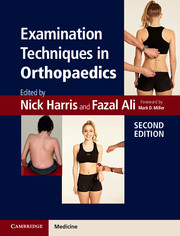Book contents
- Frontmatter
- Dedication
- Contents
- List of contributors
- Foreword
- Preface
- Acknowledgements
- 1 General principles of orthopaedic clinical examination
- 2 Examination of the shoulder
- 3 Examination of the elbow
- 4 Examination of the wrist
- 5 Examination of the hand
- 6 Examination of the peripheral nerves in the hand and upper limb
- 7 Examination of the adult spine
- 8 Examination of the hip
- 9 Examination of the knee
- 10 Examination of the foot and ankle
- 11 Examination of the brachial plexus
- 12 Orthopaedic examination techniques in children
- 13 Examination of the spine in childhood
- Index
- References
6 - Examination of the peripheral nerves in the hand and upper limb
- Frontmatter
- Dedication
- Contents
- List of contributors
- Foreword
- Preface
- Acknowledgements
- 1 General principles of orthopaedic clinical examination
- 2 Examination of the shoulder
- 3 Examination of the elbow
- 4 Examination of the wrist
- 5 Examination of the hand
- 6 Examination of the peripheral nerves in the hand and upper limb
- 7 Examination of the adult spine
- 8 Examination of the hip
- 9 Examination of the knee
- 10 Examination of the foot and ankle
- 11 Examination of the brachial plexus
- 12 Orthopaedic examination techniques in children
- 13 Examination of the spine in childhood
- Index
- References
Summary
Introduction
Productive examination of the peripheral nerves in the upper limb is based on a comprehensive knowledge of the anatomy of the brachial plexus and the course of the nerves as they pass distally. Examination of the terminal components of the nerves informs us of the proximal pathology. Knowledge of dermatomal and specific sensory nerve cutaneous supply is essential (Figure 6.1).
Examination is guided by a full history. Hand dominance, main occupation, hobbies and past injuries or neurological disorders should be documented, as well as the patient’s age. Age significantly affects both the quality and quantity of nerve recovery following injury. It is better in children and young adults; the rate of nerve regeneration in children is 2–3 mm per day, compared with 1–2 mm in adults.
The nature of the injury, e.g. knife or hydraulic press, should be clearly documented, as this will have a profound impact on the results of nerve surgery. In the elective situation, localization of the site of injury along the course of the nerve may be comparatively difficult. However, enquiry should be made about previous injuries or operations in the upper limb. The timing of injury or the evolution and duration of a compressive neuropathy are important. For example, if the duration of carpal tunnel compression symptoms is less than 10 months, there is a significant chance of recovery utilizing conservative measures.
- Type
- Chapter
- Information
- Examination Techniques in Orthopaedics , pp. 73 - 84Publisher: Cambridge University PressPrint publication year: 2014



